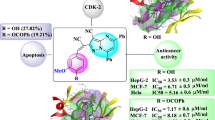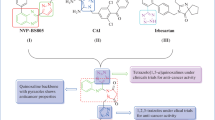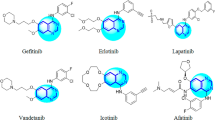Abstract
In this study, new cytotoxic agents based on 2-aminobenzamide scaffold were designed, synthesized and evaluated against A549, HCT116 and HT-29 cancer cell lines (inhib%) in doses of 5 μM and 20 μM that displayed moderate to good effects. The synthesized compounds were evaluated for their inhibitory activity (inhib%) against Pan-HDAC on HCT116 and HT-29 cell lines which displayed inhibitory activity (%) of 0–67.34% on HT-29 and 5.67–50.18% on HCT116 cell line at concentrations of 100 μM. Generally, Pan-HDAC inhibitory activity (inhib%) in (E)-N-(2-aminophenyl)-2-styrylquinoline-4-carboxamide series was better than N-(2-aminophenyl)-2-methylquinoline-4-carboxamide series. The most potent compounds 7h, 7i, 8b, 8c, 8l and 8j were selected to determine IC50 values. Interestingly, the most cytotoxicity was calculated for small size molecules of 7h and 7i from N-(2-aminophenyl)-2-methylquinoline-4-carboxamide series, 2.4 μM (HCT116) and 6.4 μM (HT-29) for compound 7h and 5.2 μM (HCT116) and 10.65 μM (HT-29) for compound 7i. Compound 8j (5.8 μM) and compound 8l (8.5 μM) from (E)-N-(2-aminophenyl)-2-styrylquinoline-4-carboxamide series displayed the most cytotoxicity on HCT116 cell line. Docking study of selected compounds 7h, 7i, 8b, 8c, 8l, and 8j was performed on HDAC isoforms that exhibited the best docking scores on sirtuins. Generally, predicted ADME properties for synthesized compounds with the pkCSM web-tool were appropriate. Based on Molinspiration Calculations, the synthesized compounds displayed the best scores as Kinase inhibitor range from 0.06 to 0.24 and then as Enzyme inhibitor range from -0.01 to 0.19.








Similar content being viewed by others
References
Ouyang Y, Li J, Chen X, Fu X, Sun S, Wu Q. Chalcone derivatives: role in anticancer therapy. Biomolecules. 2021;11:894.
Ramaiah MJ, Tangutur AD, Manyam RR. Epigenetic modulation and understanding of HDAC inhibitors in cancer therapy. Life Sci. 2021;277:119504.
Routholla G, Pulya S, Patel T, Adhikari N, Amin SA, Paul M, et al. Design, synthesis and binding mode of interaction of novel small molecule o-hydroxy benzamides as HDAC3-selective inhibitors with promising antitumor effects in 4T1-Luc breast cancer xenograft model. Bioorg Chem. 2021;117:105446.
Xiang Y-F, Qian C-W, Xing G-W, Hao J, Xia M, Wang Y-F. Anti-herpes simplex virus efficacies of 2-aminobenzamide derivatives as novel HSP90 inhibitors. Bioorg medicinal Chem Lett. 2012;22:4703–6.
Mabkhot YN, Al-Majid AM, Barakat A, Al-Showiman SS, Al-Har MS, Radi S, et al. Synthesis and biological evaluation of 2-Aminobenzamide derivatives as antimicrobial agents: Opening/Closing pharmacophore site. Int J Mol Sci. 2014;15:5115–27.
McClarty B, Rodriguez G, Dong H. Dose effects of histone deacetylase inhibitor tacedinaline (CI-994) on antipsychotic haloperidol-induced motor and memory side effects in aged mice. Front Neurosci. 2021;15:674745.
Iaconelli J, Xuan L, Karmacharya R. HDAC6 modulates signaling pathways relevant to synaptic biology and neuronal differentiation in human stem cell-derived neurons. Int J Mol Sci. 2019;20:1605.
Hamblett CL, Methot JL, Mampreian DM, Sloman DL, Stanton MG, Kral AM, et al. The discovery of 6-amino nicotinamides as potent and selective histone deacetylase inhibitors. Bioorg Med Chem Lett. 2007;17:5300–9.
Routholla G, Pulya S, Patel T, Amin SA, Adhikari N, Biswas S, et al. Synthesis, biological evaluation, and molecular docking analysis of novel linker-less benzamide based potent and selective HDAC3 inhibitors. Bioorg Chem. 2021;114:105050.
Omidkhah N, Eisvand F, Hadizadeh F, Zarghi A, Ghodsi R. synthesis, cytotoxicity, Pan-HDAC inhibitory activity and docking study of N-(2-Aminophenyl)-2-arylquinoline-4- and N-(2-Aminophenyl)-2-arylbenzo[h]quinoline-4-carboxamides**. ChemistrySelect. 2022;7(29):e202201239.
Omidkhah N, Hadizadeh F, Abnous K, Ghodsi R. Synthesis, structure activity relationship and biological evaluation of a novel series of quinoline–based benzamide derivatives as anticancer agents and histone deacetylase (HDAC) inhibitors. J Mol Struct. 2022;1267:133599. https://doi.org/10.1016/j.molstruc.2022.133599.
Omidkhah N, Ghodsi R. NO-HDAC dual inhibitors. Eur J Med Chem. 2022;227:113934.
Omidkhah N, Hadizadeh F, Ghodsi R. Dual HDAC/BRD4 inhibitors against cancer. Med Chem Res. 2021;30:1822–36.
Tang C, Wang X, Jin Y, Wang F. Recent advances in HDAC-targeted imaging probes for cancer detection. Biochim Biophys Acta (BBA)-Rev Cancer. 2022;1877(5):188788.
Su M, Gong X, Liu F. An update on the emerging approaches for histone deacetylase (HDAC) inhibitor drug discovery and future perspectives. Expert Opin Drug Discov. 2021;16:745–61.
De Filippis B, Ammazzalorso A, Fantacuzzi M, Giampietro L, Maccallini C, Amoroso R. Anticancer activity of stilbene‐based derivatives. ChemMedChem. 2017;12:558–70.
Khan ZA, Iqbal A, Shahzad SA. Synthetic approaches toward stilbenes and their related structures. Mol Diversity. 2017;21:483–509.
Teka T, Lele Z, Xiaoyan G, Li Y, Lifeng H, Xiaohui Y. Stilbenes: Source plants, chemistry, biosynthesis, pharmacology, application and problems related to their clinical Application-A comprehensive review. Phytochemistry. 2022;197:113128.
Penthala NR, Janganati V, Bommagani S, Crooks PA. Synthesis and evaluation of a series of quinolinyl trans-cyanostilbene analogs as anticancer agents. MedChemComm. 2014;5:886–90.
Srivastava V, Lee H. Synthesis and bio-evaluation of novel quinolino-stilbene derivatives as potential anticancer agents. Bioorg Med Chem. 2015;23:7629–40.
Hussain M, Singh DK, Singh A, Asad M, Ansari M, Shameem M, et al. A novel benzocoumarin-stilbene hybrid as a DNA ligase I inhibitor with in vitro and in vivo anti-tumor activity in breast cancer models. Sci Rep. 2017;7:1–14.
Banik K, Ranaware AM, Harsha C, Nitesh T, Girisa S, Deshpande V, et al. Piceatannol: A natural stilbene for the prevention and treatment of cancer. Pharmacol Res. 2020;153:104635.
Parida PK, Mahata B, Santra A, Chakraborty S, Ghosh Z, Raha S, et al. Inhibition of cancer progression by a novel trans-stilbene derivative through disruption of microtubule dynamics, driving G2/M arrest, and p53-dependent apoptosis. Cell Death Dis. 2018;9:1–18.
Giardina GA, Sarau HM, Farina C, Medhurst AD, Grugni M, Raveglia LF, et al. Discovery of a novel class of selective non-peptide antagonists for the human neurokinin-3 receptor. 1. Identification of the 4-quinolinecarboxamide framework. J Med Chem. 1997;40:1794–807.
Omidkhah N, Ghodsi R. Synthesis of novel 2-methyl-4-carboxyquinolines, the new by-products of the Doebner reaction. Synth Commun. 2021;51:1947–55.
Pashaei H, Rouhani A, Nejabat M, Hadizadeh F, Mirzaei S, Nadri H, et al. Synthesis and molecular dynamic simulation studies of novel N-(1-benzylpiperidin-4-yl) quinoline-4-carboxamides as potential acetylcholinesterase inhibitors. J Mol Struct. 2021;1244:130919.
Namballa HK, Anchi P, Manasa KL, Soni JP, Godugu C, Shankaraiah N, et al. β-Carboline tethered cinnamoyl 2-aminobenzamides as class I selective HDAC inhibitors: Design, synthesis, biological activities and modelling studies. Bioorg Chem. 2021;117:105461.
Zhang B, Zhang Q, Liu Z, Wang N, Jin H, Liu F, et al. Synthesis and anticancer research of N‐(2‐aminophenyl) benzamide acridine derivatives as dual topoisomerase I and isoform‐selective HDAC inhibitors. ChemistrySelect. 2020;5:8311–8.
Zhang GH, Gan YH. Combination of Pan-HDAC inhibitor and COX-2 inhibitor produces synergistic anticancer effects in human salivary adenoid cystic cancer cells. Chin J Dent Res. 2019;22:221–7.
Cappellacci L, Perinelli DR, Maggi F, Grifantini M, Petrelli R. Recent progress in histone deacetylase inhibitors as anticancer agents. Curr Med Chem. 2020;27:2449–93.
Eckschlager T, Plch J, Stiborova M, Hrabeta J. Histone deacetylase inhibitors as anticancer drugs. Int J Mol Sci. 2017;18:1414.
Lavu S, Boss O, Elliott PJ, Lambert PD. Sirtuins—novel therapeutic targets to treat age-associated diseases. Nat Rev Drug Discov. 2008;7:841–53.
Ediriweera MK, Tennekoon KH, Samarakoon SR. Emerging role of histone deacetylase inhibitors as anti-breast-cancer agents. Drug Discov Today. 2019;24:685–702.
Bell EW, Zhang Y. DockRMSD: an open-source tool for atom mapping and RMSD calculation of symmetric molecules through graph isomorphism. J Cheminformatics. 2019;11:1–9.
Lipinski CA, Lombardo F, Dominy BW, Feeney PJ. Experimental and computational approaches to estimate solubility and permeability in drug discovery and development settings. Adv Drug Deliv Rev. 1997;23:3–25.
Duan Y-C, Jin L-F, Ren H-M, Zhang S-J, Liu Y-J, Xu Y-T, et al. Design, synthesis, and biological evaluation of novel dual inhibitors targeting lysine specific demethylase 1 (LSD1) and histone deacetylases (HDAC) for treatment of gastric cancer. Eur J Med Chem. 2021;220:113453.
Bhal SK, Kassam K, Peirson IG, Pearl GM. The rule of five revisited: applying log D in place of log P in drug-likeness filters. Mol Pharmaceutics. 2007;4:556–60.
Kaboudi N, Shayanfar A. Predicting the drug clearance pathway with structural descriptors. Eur J Drug Metab Pharmacokinetics. 2022;47:363–9.
Pires DE, Blundell TL, Ascher DB. pkCSM: predicting small-molecule pharmacokinetic and toxicity properties using graph-based signatures. J Med Chem. 2015;58:4066–72.
Yang F, Han L, Zhao N, Yang Y, Ge D, Zhang H, et al. Synthesis and biological evaluation of thiophene-based hydroxamate derivatives as HDACis with antitumor activities. Future Med Chem. 2020;12:655–72.
Li X, Inks ES, Li X, Hou J, Chou CJ, Zhang J, et al. Discovery of the first N-hydroxycinnamamide-based histone deacetylase 1/3 dual inhibitors with potent oral antitumor activity. J Med Chem. 2014;57:3324–41.
Belayet JB, Beamish S, Rahaman M, Alanani S, Virdi RS, Frick DN, et al. Development of a novel, small-molecule brain-penetrant histone deacetylase inhibitor that enhances spatial memory formation in mice. J Med Chem. 2022;65:3388–403.
Krieger V, Hamacher A, Gertzen CG, Senger J, Zwinderman MR, Marek M, et al. Design, multicomponent synthesis, and anticancer activity of a focused histone deacetylase (HDAC) inhibitor library with peptoid-based cap groups. J Med Chem. 2017;60:5493–506.
Avelar LAA, Schrenk C, Sönnichsen M, Hamacher A, Hansen FK, Schliehe-Diecks J, et al. Synergistic induction of apoptosis in resistant head and neck carcinoma and leukemia by alkoxyamide-based histone deacetylase inhibitors. Eur J Med Chem. 2021;211:113095.
Author information
Authors and Affiliations
Corresponding author
Ethics declarations
Conflict of interest
The authors declare no competing interests.
Additional information
Publisher’s note Springer Nature remains neutral with regard to jurisdictional claims in published maps and institutional affiliations.
Supplementary information
Rights and permissions
Springer Nature or its licensor (e.g. a society or other partner) holds exclusive rights to this article under a publishing agreement with the author(s) or other rightsholder(s); author self-archiving of the accepted manuscript version of this article is solely governed by the terms of such publishing agreement and applicable law.
About this article
Cite this article
Omidkhah, N., Hadizadeh, F., Zarghi, A. et al. Synthesis, cytotoxicity, Pan-HDAC inhibitory activity and docking study of new N-(2-aminophenyl)-2-methylquinoline-4-carboxamide and (E)-N-(2-aminophenyl)-2-styrylquinoline-4-carboxamide derivatives as anticancer agents. Med Chem Res 32, 506–524 (2023). https://doi.org/10.1007/s00044-023-03018-w
Received:
Accepted:
Published:
Issue Date:
DOI: https://doi.org/10.1007/s00044-023-03018-w




